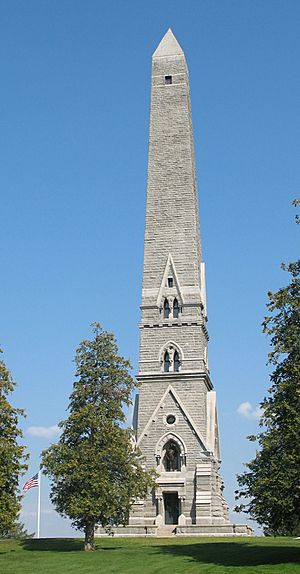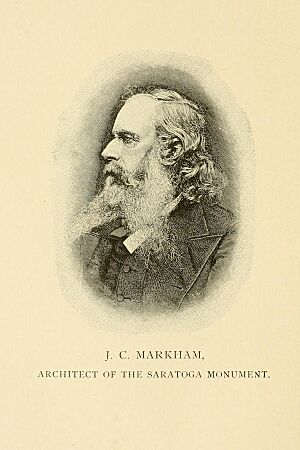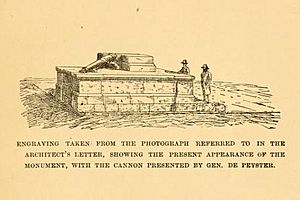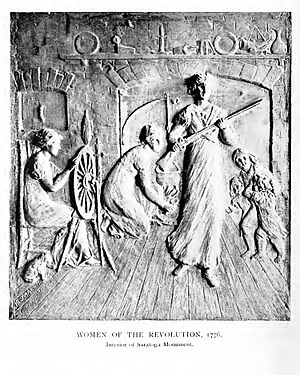Saratoga Battle Monument facts for kids
The Saratoga Battle Monument is a tall stone tower in Victory, Saratoga County, New York. It stands about 155 feet (47 meters) high. This monument celebrates a very important event in the American Revolution. It marks the spot where British forces, led by General John Burgoyne, surrendered to the American army under General Horatio Gates. This moment is often called the "Turning Point" of the American Revolution.
Contents
What Does the Monument Look Like?
The Saratoga Battle Monument sits on a high hill. From this spot, you can see the beautiful Hudson Valley.
Inside the monument, there are 188 steps. These steps lead up through five different levels to a viewing platform at the very top. On the walls of the first two levels, you'll find 16 bronze plaques. These plaques show exciting scenes from the American Revolution. Other cool things inside include colorful ceramic tiles, shiny brass decorations, and pretty stained glass windows.
Statues Inside the Monument
The monument has four special spots, called niches, for large bronze statues. These statues honor American commanders who were important in the Battle of Saratoga.
- General Horatio Gates: His statue faces north. He was the main commander of the American army during the battles. He looks north, as if waiting for the British army to arrive from that direction.
- General Philip Schuyler: His statue faces east. His home was downhill and east of the monument. The British burned his estate when they were leaving the battlefield.
- Colonel Daniel Morgan: His statue faces west. His skilled riflemen and light infantry troops were positioned west of the monument. They were there to stop the British from escaping in that direction.
- The Empty Niche: One spot is empty. It faces south, towards the battlefield. This spot was originally meant for a statue of American General Benedict Arnold.
Building the Monument: A Team Effort
In 1856, a group of people met to talk about building a monument. They wanted to celebrate the American victory at the Battle of Saratoga. In 1859, they officially formed the Saratoga Monument Association. This group worked to make the monument a reality.
The association chose the perfect spot for the monument. However, their plans were put on hold because of the American Civil War. After the war, in 1872, they started working on the monument again. The New York State Legislature even approved $50,000 to help build it.
Laying the Cornerstone
On October 17, 1877, exactly 100 years after Burgoyne surrendered, a special ceremony took place. They laid the first stone, called the cornerstone, of the monument. It was a big celebration with a two-mile-long parade, music, and speeches.
Who Designed and Built It?
The monument was designed by John C. Markham from New Jersey. The very top stone was put in place on November 3, 1882. The bronze statues inside were finished in August 1887.
The statues were created by different artists:
- George Bissell made the statue of General Gates.
- Alexander Doyle made the statue of General Schuyler.
- William O'Donovan made the statue of Colonel Morgan.
John C. Markham also designed the 16 bronze plaques inside the monument.
The monument was officially opened and given to New York State on October 18, 1912. Later, in 1980, the state gave the monument to the US National Park Service.
Funding the Project
Building the Saratoga Battle Monument cost a lot of money. Private donations contributed $2,300. The federal government gave $95,000, and New York State added $10,000. Many people also donated their time and materials.
Keeping the Monument Strong
By 1987, the monument needed a lot of repairs. It had to be closed because it wasn't safe. A big renovation project began, costing $3 million. The monument was reopened on Columbus Day in 2005. The National Park Service provided the money for these repairs.





